ASEAN Geospatial Analytics Market Size
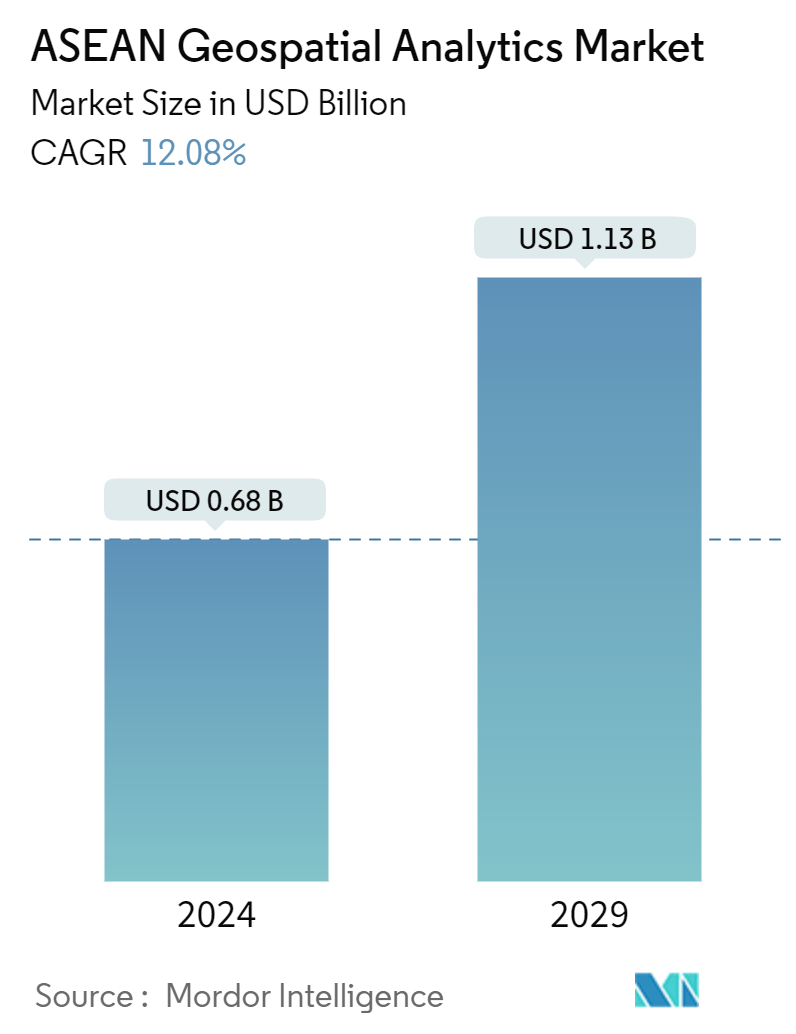
| Study Period | 2019 - 2029 |
| Base Year For Estimation | 2023 |
| Market Size (2024) | USD 0.68 Billion |
| Market Size (2029) | USD 1.13 Billion |
| CAGR (2024 - 2029) | 12.08 % |
| Market Concentration | Medium |
Major Players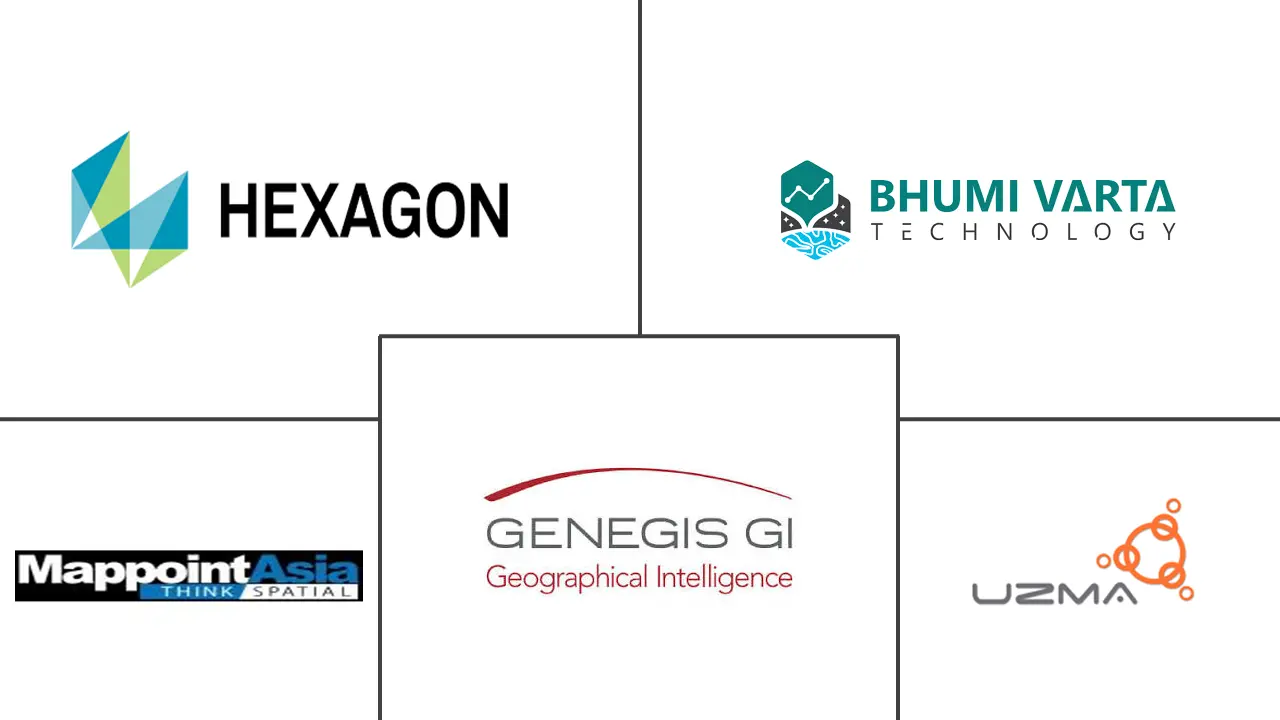
*Disclaimer: Major Players sorted in no particular order |
ASEAN Geospatial Analytics Market Analysis
The ASEAN Geospatial Analytics Market size is estimated at USD 0.68 billion in 2024, and is expected to reach USD 1.13 billion by 2029, growing at a CAGR of 12.08% during the forecast period (2024-2029).
The ASEAN Geospatial Analytics market is majorly driven by the growth in innovative solutions by major market vendors coupled with increasing 5G rollout and integration of advanced technologies such as AI and ML in geospatial analytics solutions.
- The ASEAN geospatial analytics market is witnessing substantial growth over the past few years owing to the evolving role of national geospatial organizations in driving geospatial market growth coupled with the increasing government's efforts to boost the geospatial ecosystem and increasing demand from various end-user industries such as agriculture, environmental monitoring and urban development in South East Asian countries.
- Further, the continuous innovations and integration of advanced technologies such as artificial intelligence and machine learning in geospatial analytics by the leading regional as well as global companies in the region are one of the major factors driving the demand for geospatial solutions in end-user industries across the region. For instance, Indonesia-based Bhumi Varta Technology offers Spatial analysis and analytics with Artificial Intelligence (AI) and machine learning (ML) to lead enterprises to actionable insights.
- Furthermore, the growth in the rollout of 5G services across ASEAN countries is expected to boost the development of the market as 5G technology will accelerate the GIS adoption, enabling the efficient creation of spatial data, thereby furthering geospatial analytics deployment across industries in the ASEAN region. For instance, according to the Ericsson Mobility Report, 5G is expected to become the leading technology in subscriptions in Southeast Asia by 2028, with a penetration rate of 48%.
- Additionally, the use of geospatial analytics is rapidly increasing in smart city projects across ASEAN countries. To better serve the public, smart cities leverage geospatial analytics and all the insights that come with it to make data-driven decisions.
- Market vendors such as Esri Singapore offer geospatial platforms and partner with governments to develop smarter cities and provide better services to the community. Such factors are further expected to elevate the market growth in the coming years.
ASEAN Geospatial Analytics Market Trends
Agriculture Segment is Anticipated to Witness Significant Traction
- The agricultural segment is expected to witness substantial adoption of geospatial analytics in the ASEAN countries in the coming years. Increasing support from governments to boost smart farming and precision agriculture practices, coupled with the growing demand for geospatial solutions in soil mapping, soil management, crop monitoring, and farm management, is analyzed to influence the demand for geospatial analytics in the agriculture sector.
- Moreover, Geospatial analytics demand is further expected to grow to analyze soil data to determine which crops may grow in specific locations. Additionally, adopting geospatial analytics allows more accurate mapping of geographic and geologic features of crop fields, thus enabling farmers to create more efficient farming methods and increase crop yield. Such factors are further analyzed to boost the adoption of geospatial analytics in the agriculture sector across Southeast Asian countries in the coming years.
- Additionally, the growth in precision farming and smart farming across ASEAN nations is also analyzed to drive the adoption of geospatial analytics solutions in the coming years. Many countries government's is introducing policies to boost the adoption of smart farming to boost the agriculture sector. For instance, as part of the Thailand 4.0 national policy, several measures have been implemented by the Thai Government to push the agriculture industry into an era of smart farming.
- Moreover, the agriculture sector in countries like Thailand and Malaysia is witnessing substantial growth and actively contributing to the growth in Gross Domestic Product, as there has been a significant increase in the application of smart and precision farming technologies in the region. With growing smart farming and precision agriculture in the region, geospatial analytics demand is expected to grow to survey and map plantation crops such as rice and oil palms. For instance, according to the data from OAE, in 2023, the total value of agricultural products exported from Thailand reached around 1.78 trillion Thai baht (48.46 USD Billion).
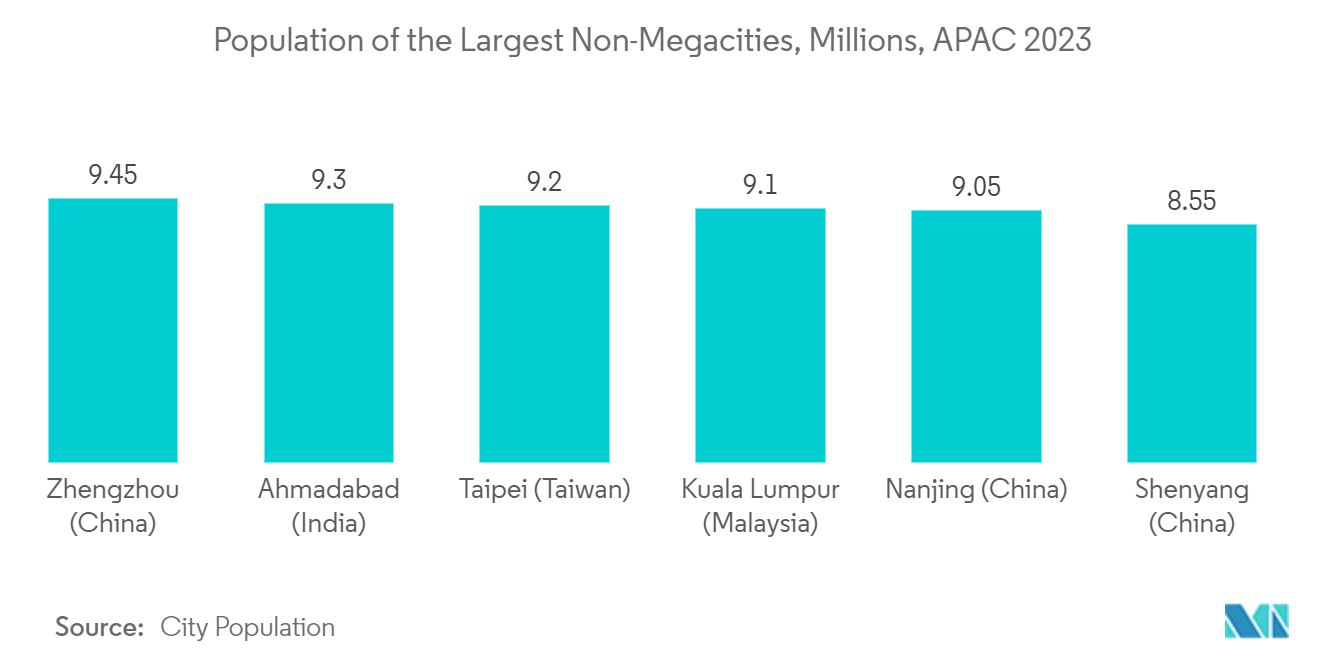
Singapore is Expected to Witness Substantial Growth
- Singapore is expected to witness substantial growth in adoption of geospatial analytics in various end-user industries ranging from healthcare, defence to government. Additionally, technological innovations in the geospatial field, coupled with the increasing initiatives and partnerships from the Singapore Land Authority in the geospatial ecosystem, are analyzed to positively influence the market's growth in the coming years.
- For instance, in March 2023, the Singapore Land Authority (SLA) signed a bilateral collaboration with the General Authority for Survey and Geospatial Information of the Kingdom of Saudi Arabia (GEOSA). Over three years, GEOSA and SLA will exchange experiences and knowledge on developing national geospatial databases, digital transformation in the geospatial industry, developing Digital Twins, and developing geospatial products and services.
- Moreover, the country's urban population growth in the past few years is further driving the demand for geospatial analytics for urban planning tasks such as site selection, examining urban growth and extension patterns, etc. For instance, according to the UNESCAP data, Singapore's urban population increased from 4265.7 thousand in 2005 to 5896.7 thousand in 2022.
- The real estate sector is also expected to witness substantial adoption of geospatial analytics in Singapore over the forecast period. Real estate companies and associations are partnering with SLA to boost the adoption of geospatial solutions in the real estate sector. For instance, in June 2022, the Singapore Land Authority (SLA) signed a Memorandum of Understanding (MOU) with the Real Estate Developers' Association of Singapore (REDAS) to promote the adoption of geospatial technology and drive geospatial innovation in the country. Under the MOU, REDAS and SLA will jointly promote awareness of geospatial technologies. Additionally, both entities will organize joint events and capability development programs to address the challenges faced by real estate and related industries.
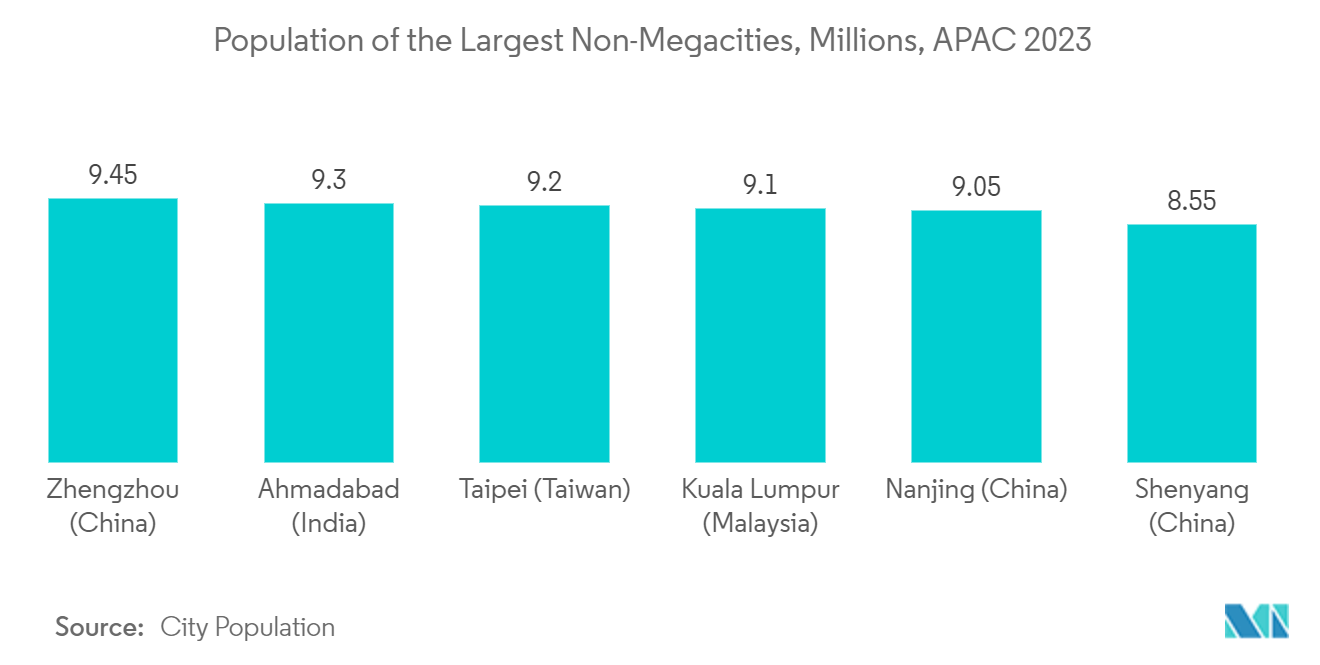
ASEAN Geospatial Analytics Industry Overview
The ASEAN geospatial analytics market is moderately competitive due to the presence of several minor and major businesses. The market is moderately concentrated, with major companies employing collaborations and product innovation tactics. GIS Co., Ltd., MappointAsia (Thailand) Public Company Limited, Geospatial AI Sdn Bhd (Uzma Berhad), Hexagon AB, PT. Bhumi Varta Technology, etc., are a few of the market's top competitors.
In June 2022, Rezatec announced its partnership with Geospatial AI Sdn Bhd, a geospatial analytics firm owned by Uzma Group. The two companies will deliver geospatial data, satellite imagery, and cloud-based analytics to utility companies across Malaysia. Customers across Malaysia will now benefit from cost-effective, more efficient, remote, and scalable monitoring of their ground-based assets and inventory.
ASEAN Geospatial Analytics Market Leaders
-
GIS Co., Ltd.
-
MappointAsia (Thailand) Public Company Limited
-
Geospatial AI Sdn Bhd (Uzma Berhad)
-
Hexagon AB
-
PT. Bhumi Varta Technology
*Disclaimer: Major Players sorted in no particular order
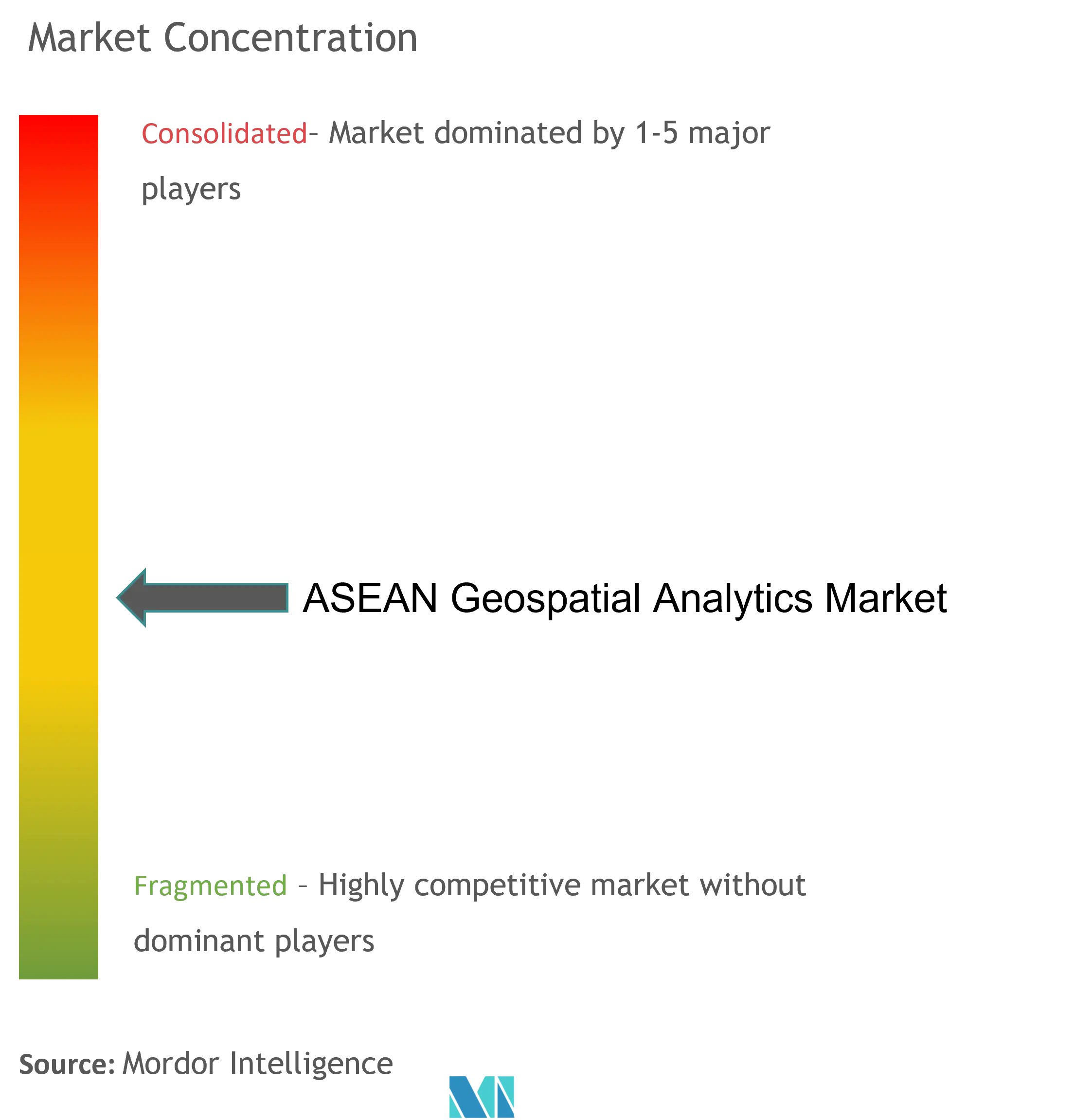
ASEAN Geospatial Analytics Market News
- March 2023: The Singapore Land Authority (SLA) announced a Memorandum of Understanding (MOU) with the Container Depot and Logistics Association (Singapore), or CDAS, to improve the routing of heavy vehicles. Under the two-year partnership, CDAS and SLA will utilize geospatial data such as road conditions and restrictions to enable the CDAS's member companies to route their heavy vehicles efficiently and safely.
- August 2022: Thaicom Public Company Limited, one of Asia's leading satellite operators, signed a strategic partnership agreement with US-based Orbital Insight Inc., a geospatial analytics and location intelligence technology company, to enable Thaicom to deliver leading data insights and intelligence services leveraging space-based technology and other sources with Orbital Insight Inc.'s geospatial analytics platform to its consumers in Thailand and the region.
ASEAN Geospatial Analytics Market Report - Table of Contents
1. INTRODUCTION
- 1.1 Study Assumptions and Market Definition
- 1.2 Scope of the Study
2. RESEARCH METHODOLOGY
3. EXECUTIVE SUMMARY
4. MARKET INSIGHTS
- 4.1 Market Overview
-
4.2 Industry Attractiveness - Porter's Five Forces Analysis
- 4.2.1 Bargaining Power of Buyers
- 4.2.2 Bargaining Power of Suppliers
- 4.2.3 Threat of New Entrants
- 4.2.4 Threat of Substitutes
- 4.2.5 Intensity of Competitive Rivalry
- 4.3 Industry Value Chain Analysis
- 4.4 Assessment of the Impact of COVID-19 on the Market
5. MARKET DYNAMICS
-
5.1 Market Drivers
- 5.1.1 Increase in Demand for Geospatial Analytics in Smart City Development and Urban Planning
- 5.1.2 Growth in 5G Deployment to Boost the Market Growth
-
5.2 Market Restraints
- 5.2.1 Higher Costs Associated With Geospatial Analytics Solutions
6. MARKET SEGMENTATION
-
6.1 By Type
- 6.1.1 Surface Analysis
- 6.1.2 Network Analysis
- 6.1.3 Geo Visualization
-
6.2 By End-user Vertical
- 6.2.1 Agriculture
- 6.2.2 Utility and Communication
- 6.2.3 Defense and Intelligence
- 6.2.4 Government
- 6.2.5 Mining and Natural Resources
- 6.2.6 Automotive and Transportation
- 6.2.7 Healthcare
- 6.2.8 Real Estate and Construction
- 6.2.9 Other End-user Verticals
-
6.3 By Country
- 6.3.1 Thailand
- 6.3.2 Malaysia
- 6.3.3 Indonesia
- 6.3.4 Singapore
7. COMPETITIVE LANDSCAPE
-
7.1 Company Profiles
- 7.1.1 GIS Co., Ltd.
- 7.1.2 MappointAsia (Thailand) Public Company Limited
- 7.1.3 Geospatial AI Sdn Bhd (Uzma Berhad)
- 7.1.4 Hexagon AB
- 7.1.5 PT. Bhumi Varta Technology
- 7.1.6 ESRI (Thailand) Co., Ltd.
- 7.1.7 Intermap Technologies
- 7.1.8 Mandalay Technology Co., Ltd.
- 7.1.9 Spatialworks Sdn Bhd
- 7.1.10 SkyMap Global
- *List Not Exhaustive
8. INVESTMENT ANALYSIS
9. MARKET OPPORTUNITIES AND FUTURE TRENDS
** Subject To AvailablityASEAN Geospatial Analytics Industry Segmentation
Geospatial analytics is the process of acquiring, manipulating, and displaying imagery and data from the geographic information system (GIS), such as satellite photos and GPS data. The specific identifiers of a street address and a zip code are used in geospatial data analytics. They are used to create geographic models and data visualizations for more accurate trend modelling and forecasting.
The ASEAN geospatial analytics market is segmented by type (surface analysis, network analysis, geovisualization), end user vertical (agriculture, utility and communication, defence and intelligence, government, mining and natural resources, automotive and transportation, healthcare, real estate and construction), and country (Thailand, Indonesia, Malaysia, Singapore). The market sizes and forecasts are provided in terms of USD value for all the above segments.
| By Type | Surface Analysis |
| Network Analysis | |
| Geo Visualization | |
| By End-user Vertical | Agriculture |
| Utility and Communication | |
| Defense and Intelligence | |
| Government | |
| Mining and Natural Resources | |
| Automotive and Transportation | |
| Healthcare | |
| Real Estate and Construction | |
| Other End-user Verticals | |
| By Country | Thailand |
| Malaysia | |
| Indonesia | |
| Singapore |
ASEAN Geospatial Analytics Market Research Faqs
How big is the ASEAN Geospatial Analytics Market?
The ASEAN Geospatial Analytics Market size is expected to reach USD 0.68 billion in 2024 and grow at a CAGR of 12.08% to reach USD 1.13 billion by 2029.
What is the current ASEAN Geospatial Analytics Market size?
In 2024, the ASEAN Geospatial Analytics Market size is expected to reach USD 0.68 billion.
Who are the key players in ASEAN Geospatial Analytics Market?
GIS Co., Ltd., MappointAsia (Thailand) Public Company Limited, Geospatial AI Sdn Bhd (Uzma Berhad), Hexagon AB and PT. Bhumi Varta Technology are the major companies operating in the ASEAN Geospatial Analytics Market.
What years does this ASEAN Geospatial Analytics Market cover, and what was the market size in 2023?
In 2023, the ASEAN Geospatial Analytics Market size was estimated at USD 0.60 billion. The report covers the ASEAN Geospatial Analytics Market historical market size for years: 2019, 2020, 2021, 2022 and 2023. The report also forecasts the ASEAN Geospatial Analytics Market size for years: 2024, 2025, 2026, 2027, 2028 and 2029.
ASEAN Geospatial Analytics Industry Report
Statistics for the 2024 ASEAN Geospatial Analytics market share, size and revenue growth rate, created by Mordor Intelligence™ Industry Reports. ASEAN Geospatial Analytics analysis includes a market forecast outlook to for 2024 to 2029 and historical overview. Get a sample of this industry analysis as a free report PDF download.



